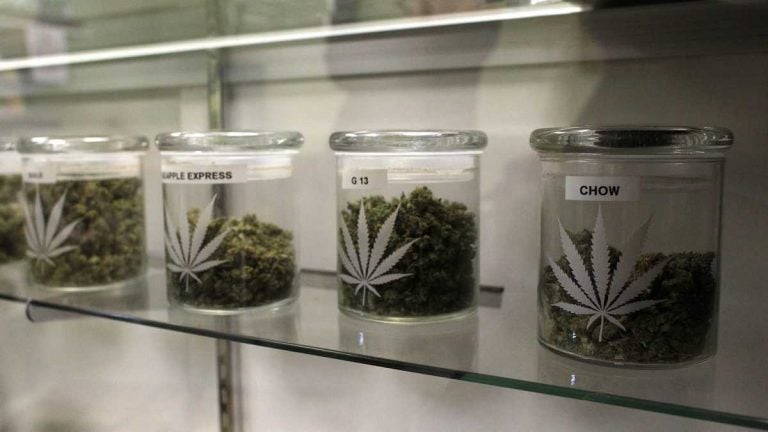N.J. calls for big increase in number of medical marijuana dispensaries
New Jersey's current medical marijuana program won’t come close to meeting a surging demand, the health department says.

The number of medical marijuana patients has more than doubled in the last year. (Brennan Linsley/AP Photo)
This story originally appeared on NJ Spotlight.
—
New Jersey health officials on Monday recommended a huge increase in the number of medicinal marijuana dispensaries, arguing that the current handful of so-called Alternative Treatment Centers won’t be nearly enough to meet surging demand.
The Department of Health said the state will need 50 to 90 of the centers in the next three years to keep up with the sharp growth in the number of people using marijuana for medical purposes. The proposed total would be at least eight times the current six dispensaries.
The number of patients participating in New Jersey’s Medicinal Marijuana Program is growing at about 100 a day, largely driven by the Murphy administration’s addition last year of five illnesses that allow patients to receive the drug to relieve conditions such as chronic pain, end-stage cancer or post-traumatic stress disorder. In January, the administration also added opioid use disorder to the list of qualifying complaints.
The number of participants is now just under 44,000, some 27,000 of whom have joined since the start of the Murphy administration, the DOH said, in a biennial report.
The number of patients has more than doubled in the last year.
“If we continue at that current growth rate, we’re going to hit 127,000 patients by January 2022,” said Jeff Brown, assistant commissioner for medical marijuana, in an interview. “There’s no way that six dispensaries can serve 127,000 patients,” he said.
Is more research needed?
Even with an additional six dispensaries that were selected by the department last December from some 140 applicants, the system will be way behind the level it needs to meet demand, Brown said.
But Larry Downs, chief executive of the Medical Society of New Jersey, the state’s largest medical organization, urged officials not to expand the number of dispensaries until more research establishes scientific evidence that marijuana is a safe and effective way of treating illness.
“The doctors remain skeptical about the expanded conditions and the expanded demand,” said Downs, who represents about 7,500 physicians. “There are a lot of very expensive and very well tested pharmaceuticals that have great indications for the diseases they are targeted to. The same can’t be said for medical marijuana.”
“The medical society believes that the program should not be radically expanded until there’s an adequate research base in place,” Downs said. “Until that happens, it’s really not supportable to expand the program.”
To facilitate the research, the federal government would have to change its classification of marijuana from a Schedule 1 narcotic to Schedule 2, giving doctors the opportunity to fully investigate its effectiveness for certain conditions, he said. The medical society, together with equivalent organizations in four other states, has recently asked the federal government to make that change.
Therapeutic benefits unclear
The National Institute of Drug Abuse, a nonprofit research group, also urged a cautious approach to the use of medical marijuana. Although there is mounting evidence of its benefits as a medical drug, it is still unclear whether the therapeutic benefits outweigh the health risks, the institute said.
Despite such doubts, the number of physicians participating in the New Jersey program has grown by some 40 percent since the Murphy administration took office in January 2018, according to the DOH.
Meanwhile, the department’s Division of Medicinal Marijuana also recommended increasing the current legal limit of two ounces per person per month in light of its findings that some patients use all their allowance.
It advocated a non-specific “incremental” increase in the limit for all patients and the elimination of the limit for terminally ill patients.
“Given that there are some significant debilitating conditions that are treated with medical cannabis, we think that’s a sign that folks might need in excess of that limit when their symptoms are particularly bad,” Brown said.
He declined to specify a level to which the DOH wants the limit raised but said the department supports current legislation — bills A-10 and S-10 — that would increase it first to 2.5 ounces and then to 3 ounces.
Revenues doubled in 2018
The top medical conditions for qualified patients are chronic pain because of muscular or skeletal disorders (25 percent), anxiety (20 percent), and intractable skeletal spasticity (also 20 percent), the DOH said.
The six dispensaries, which are run as private nonprofits, almost doubled their revenue to $53 million in 2018 from $29 million a year earlier, the report said.
It found that prices on the regulated market were comparable to those on the street as long as patients were eligible for discounts. But those without a discount at five dispensaries paid $100 more per ounce than the illegal market price.
To keep dispensary prices below the illegal level, the state should increase supply by increasing the number of growers, the report said.
“Keeping prices below the illegal market is the best way to ensure patients purchase lab-tested products at regulated dispensaries and responsibly use the therapy under the supervision of a health-care provider,” Brown said.
WHYY is your source for fact-based, in-depth journalism and information. As a nonprofit organization, we rely on financial support from readers like you. Please give today.




